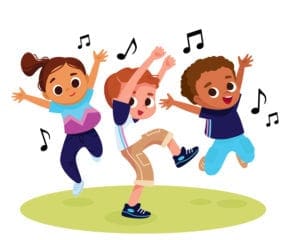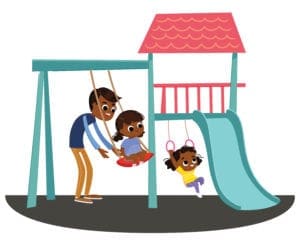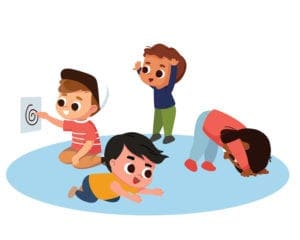What is the vestibular system, and what does it mean for my child?
The vestibular system helps us interpret movement–if we are moving or standing still, how fast we are moving if we are moving with or against gravity, and what direction we are moving in. It is housed within our inner ear and receives information based on the direction that our head moves.
When it is functioning appropriately, the vestibular system helps us feel balanced and move about our environments. If it is not functioning properly, your child might often feel nauseous or dizzy, lose his/her balance easily, bump into things more often than others, display poor posture, or appear to crave rocking or swinging, among other factors.
In addition, it is important to note that it can be challenging to find the “just right” amount of vestibular input for your child. Vestibular input can be both alerting and calming, and can quickly become overwhelming. While the vestibular system detects all movement, swinging, rocking, and spinning can be particularly stimulating. Needless to say, there is a lot going on here!
Further, the amount of vestibular input that your child needs could change from one day to the next. Therefore, in the case that your child appears to be overstimulated from the vestibular input (which may include your child becoming extremely energetic, appearing tired, or becoming tearful), follow the activity with proprioceptive input.
If you are in search of proprioceptive activities to follow these vestibular activities, please reference our blog post, “Fun Proprioceptive Activities Using Items You Have at Home,” for more ideas!
Benefits of Vestibular Input
We are constantly moving in our daily lives, which means the vestibular system never stops working. Its layered benefits are crucial to helping us remain functional, including its ability to:
- Tell us where our body is in space, such as whether we are standing or lying down
- Ensure that all of our muscles, from our head to our toes, are working together so we can move as we wish
- Help us maintain our balance, particularly when walking on uneven surfaces or in unfamiliar places
- Calm or alert us, to improve our attention to our surroundings
Vestibular Activities to Do at Home
The vestibular system begins forming in your mother’s womb and plays a pivotal role in our early development. Because of this, it is beneficial to intentionally partake in vestibular activities that are going to further develop this system, that we will continue to use for the rest of our lives. There are several ways to engage in vestibular activities with little to no equipment–this is just the beginning!
1. Have a Dance Party!
Turn on your child’s favorite music, and dance together! Whether it is freestyle or choreographed, the way your child moves his/her head and body is enriching the vestibular system. Any time your child spins, rocks, or swings, it is adding more vestibular input to his/her body!
For a more controlled environment, specifically, if you are concerned with your child’s safety, follow along to a song with directions or have your child copy your dance moves. For instance, the spinning involved in the song, “Ring around the Rosie,” can be alerting, while the crash to the ground at the end provides more “centering” or calming input.
You can also find songs to follow along to, such as a Freeze Dance song, on the internet. These songs can provide more structure to the activity, and often add an additional challenge to imitate what the person in the video is doing and follow along.
Whatever works for your child, keep it fun! The more light-hearted it is, the more your child will look forward to it the next time you offer a dance party.
2. Walk the Tightrope (and Other Balance Games)!
Whether it’s an old balance beam at the local park, a taped line on the carpet, or a line drawn with sidewalk chalk, any balance practice is working the vestibular system! When your child attempts to walk on the line, his/her vestibular system is at work to adjust the body and maintain an upright position, while taking precise steps forward.
Your child may need to hold your hand at first for balance, but will likely need less help over time. It takes a significant amount of focus to balance, and it can be frustrating for certain children if they are not able to maintain their balance as they feel they should. Give your child enough assistance to feel successful, and keep it fun and playful! Have your child imagine he/she is walking on a tightrope, or “can’t step in the lava, water, et cetera.” Or, add a “pot of gold” at the end of the line that he/she has to stay on the line to reach.
To add another component, with a bit more unpredictability, try having your child walk on stepping stones, or on pillows at home. This requires greater coordination and balance and simulates an uneven surface that your child might find when playing outside, such as on the playground.
When your child is ready for another challenge, add more complexity to the lines or paths! Use tape on your carpet, or sidewalk chalk on the driveway, to add curves and angles to the lines. Or, position your stepping stones or pillows a bit further apart, or create a curved or angled path. It is best to add one or two complexities at a time–any change of direction is an additional challenge! Over time, you can add loops, or make an obstacle course to reach the end goal. The possibilities are endless!
3. Play Outside!
Riding a tricycle or a bike, going down the slide, swinging, jumping on a trampoline, swimming, running; these are all great sources of vestibular input! In fact, you have likely done them with your child without even knowing that you were benefitting his/her vestibular system.
Each of these activities requires your child to detect input from the environment, and adjust his/her posture and muscles to maintain balance and continue to play. This movement-based play is nourishing your child’s vestibular system by reminding it of his/her body in space and keeping your child safe.
If you have a swing at your house or have access to one at the local playground, try pushing your child on the swing at different speeds, or in different directions. While swinging faster is alerting, swinging in a slow linear movement can be extremely calming.
Aside from the vestibular benefits, there are countless bonuses to this activity! First, play is the “work” of the child. When a child is playing, he/she is exploring the environment, learning problem-solving skills, healthy risk-taking, social skills, and other transformative skills. Play also promotes fine and gross motor skill development, spontaneously! Further, research shows that spending time in nature can improve a child’s mood and attention, which benefits overall learning!
4. There’s a Monkey on My Back!
As mentioned earlier, any change in head position requires the vestibular system to adjust. Because of this, any type of hanging provides vestibular input and can be a challenge!
This activity is a favorite for many children, and they will be happy to play at home! To play, have your child climb on your back like a monkey. Then, crawling on your hands and knees, playfully rock back and forth, side to side, change directions, and speed, trying to “get the monkey off your back.” This is a playful way to explore different head positions, and your child will surely be smiling and giggling by the end of it!
In this game, you have control over the vestibular input your child receives, so be mindful of his/her response to certain positions, as to avoid negative reactions and keep the activity fun. In general, the faster you bounce or rock, the more alerting it will be; slower motions will elicit a more calming response. It is important to note that many children do not like at least one of these positions. If this is the case for your child, that’s okay! Allow them to explore different positions and have fun playing; they will still receive vestibular input in other ways.
As an alternative to your own back, use what you have at home to receive the same benefits! If you have a therapy (or exercise) ball at home, your child can sit on it or lie on his/her stomach or back, and bounce, rock back and forth, or rock side to side. The speed in which you bounce or rock, the position your child’s head is in, and the amount of time he/she spends in this position are all factors that influence the vestibular input your child is receiving.
If you do not have a therapy ball, don’t worry! There are plenty of other ways to do these activities. Your child can lie upside down, or hang, off of a couch, or on an ottoman as well.
5. Obstacle Courses, Races, and Relays!
Obstacle courses are a favorite because they are fun, and can work on so many skills within one activity! This remains true for vestibular input activities.
Set up an obstacle course, with as few as two stations and up to as many as you’d like! Within the obstacle course, include vestibular input activities, such as:
- Wheelbarrow walks – Hold your child’s ankles, or move closer to the knees if he/she needs more support, and he/she can move forward using his/her arms to “walk”
- Running, skipping, or galloping
- Yoga poses – downward dog, bridge, cobra, etc.
- Animal walks – bear walks, crab walks, frog jumps
- Jumping, with one or two feet
- Forward rolls, or log rolls
You can also use any of these activities as a race or relay. For instance, have your child race against you, running or doing animal walks from one end of the room to another. If you have more people in your family, try a relay! Have one person do an activity–jumping, animal walks, wheelbarrow walks–across the room and back, then take turns until everyone has gone.
Vestibular input can be tricky, and it’s important to read your child’s reactions to certain positions and adjust accordingly. As with all sensory input, we all have different reactions! As always, if you have any questions about your child’s reactions to certain activities or positions, please ask your child’s therapist for further explanation or recommendations.
Contact Chicago Occupational Therapy or call (773) 980-0300 to learn more about our services and how we can help your child flourish and grow.



